The Hagia Sophia Mosque
Hagia Sophia, one of the most important structures in history, Roma It was built by the empire approximately 1500 years ago and went down in history as the largest temple of the period. This unique structure, bearing the traces of both the Islamic and Christian worlds, reflects the harmony of the two faiths. Described as the eighth wonder of the world, Hagia Sophia continues to be one of the most impressive architectural projects in human history. In particular, its dome, an engineering marvel of the period, is still admired today as one of the largest domes in the world.
IstanbulHagia Sophia, one of the oldest and most valuable structures in the world, is considered a sacred place not only for Turkey but also for all of human history and the world's cultural heritage. This unique structure, which has become the symbol of Istanbul today, was reopened for worship as a mosque in 2020. Everything you need to know about Hagia Sophia, which has been the subject of many mysteries and legends throughout history and has a fascinating architecture, is presented to you in this article.
Headlines
- 1 History of Hagia Sophia
- 2 Who Built Hagia Sophia?
- 3 What are the features of Hagia Sophia?
- 4 The Story of Hagia Sophia: Legends and Secrets
- 5 Places to See in Hagia Sophia Mosque
- 6 Where is Hagia Sophia Mosque?
- 7 How to Get to Hagia Sophia Mosque?
- 8 Hagia Sophia Mosque: Fees and Visiting Hours
- 9 Secrets and Interesting Facts of Hagia Sophia
- 10 A New Era Begins in Hagia Sophia
- 11 Hagia Sophia Awaits Visitors
History of Hagia Sophia
Hagia Sophia was rebuilt in its current location three times and repaired in different periods. Here is the historical journey of Hagia Sophia:
First Hagia Sophia
The first Hagia Sophia was built under the name Megale Ekklesia, which means “Great Church” in Greek. The construction of this structure was initiated by Emperor Constantine the Great, who declared Istanbul as the capital and organized the important Council of Nicaea for Christianity. The church was completed and opened to service by Constantine’s son Constantine. However, it was destroyed in an internal rebellion in 404 AD.
Second Hagia Sophia
The Second Hagia Sophia was rebuilt by Emperor Theodosius II in 415. However, this structure was also destroyed during the Nika Revolt in 532 AD. Today, the ruins of the Second Hagia Sophia can be seen in the garden of the mosque and on the entrance stairs.
Third Hagia Sophia
The construction process that gave Hagia Sophia its current appearance began in 532 during the reign of Emperor Justinian and was completed in 537. Approximately 10 workers and 100 apprentices worked on this gigantic project, which brought the structure to its current glory. However, it was looted and seriously damaged by the Crusaders during the Fourth Crusade.
After the conquest of Istanbul by Fatih Sultan Mehmet in 1453, Hagia Sophia was converted into a mosque, made suitable for Islamic worship and minarets were added. In addition, Mimar Sinan renewed and reinforced the retaining walls in order to strengthen the structure. Hagia Sophia bears traces of Byzantine architecture as well as Ottoman-era marble workmanship, and this multicultural heritage is still preserved with great admiration.
Who Built Hagia Sophia?
The foundations of Hagia Sophia were laid by Emperor Justinian I during the Byzantine Roman Empire. Construction of the structure was begun in 532 by Isidoros and Anthemios, famous architects and mathematicians of the period. A marvel of great mastery and engineering, Hagia Sophia was completed in just 5 years and opened for worship in 537.
Today, Hagia Sophia serves as a mosque and continues to fascinate humanity with both its architectural magnificence and its historical importance.
What are the features of Hagia Sophia?
Hagia Sophia is a historical and religious symbol as well as a structure that is admired in terms of technical and architectural aspects. Here are the prominent features of Hagia Sophia:
- Doors: The doors of Hagia Sophia are made of oak wood, known for its durability.
- Windows and Columns: The structure has 40 large windows and 107 columns, reflecting the magnificence of Byzantine architecture.
- Marble Coverings: The walls are decorated with colored monolithic marbles brought from abroad. The white marbles were specially supplied from Marmara Island.
- Traces of Byzantine Architecture: The design and dome of Hagia Sophia represent the architectural superiority of the Byzantine period.
Elements Added During the Ottoman Period:
After Hagia Sophia was converted into a mosque during the Ottoman period, important additions were made:
- Mihrab and Pulpit
- Sultan's court
- Line signs
- Library of Mahmud I
- Muvakkithane
- Shrines
- Fountain
- Primary school
These additions increased the religious, cultural and historical importance of Hagia Sophia and transformed the building into a multicultural heritage. Today, Hagia Sophia continues to fascinate visitors with its magnificence.
The Story of Hagia Sophia: Legends and Secrets
Hagia Sophia, a UNESCO World Heritage Site, has been a sacred symbol for both the Islamic and Christian worlds for centuries. Drawing attention with its legends as well as its historical grandeur, Hagia Sophia is home to fascinating stories such as the “Enchanted Gates,” “Bees,” and the “Holy Grail.”
Enchanted Doors
The first Hagia Sophia was built with 7 doors, reflecting the magic of the number 7. It is said that the third Hagia Sophia today has exactly 361 doors. 101 of these doors are gigantic and are believed to be the most magical doors. According to legend, whenever one tries to count the doors of Hagia Sophia, one more door appears. This mysterious situation further strengthens the mystical aspect of the structure.
The Legend of the Bees
Emperor Justinian did not like the initial construction plans for Hagia Sophia. One day, during Sunday mass, a bee took the piece of holy bread he had dropped on the ground and ran away. The emperor ordered all beekeepers to find this bee. An architect who produced his own honey found the piece of bread that the bee had carried to the hive and saw that a unique church model had formed in the hive. Upon this incident, Justinian ordered the construction to be reorganized based on the piece of holy bread and the design.
The Holy Grail
Another legend about Hagia Sophia is the "Holy Grail". It is said that during the conquest of Istanbul, a priest carrying the grail in his hand disappeared through a door to prevent the grail from falling into the hands of Muslims. This story contributes to the mysterious atmosphere of Hagia Sophia.
The stories of Hagia Sophia reveal not only its architectural and historical aspects, but also its spiritual depth. For centuries, these legends have ensured that Hagia Sophia has retained its mystical charm.
Places to See in Hagia Sophia Mosque
Hagia Sophia offers a unique experience to its visitors with its fascinating architecture and historical details. Here are the must-see places in Hagia Sophia:
Enchanted Doors
The nine gates at the main entrance have been the subject of legends throughout history. During the Crusades, these gates, decorated with gold and precious stones, were used by emperors. The largest is known as the “Emperors’ Gate” and the depressions made by the guards can be seen in the marble around it. According to legend, the remains of Noah’s Ark were used in the construction of this gate. Sailors would pray at this gate before setting off on a voyage.
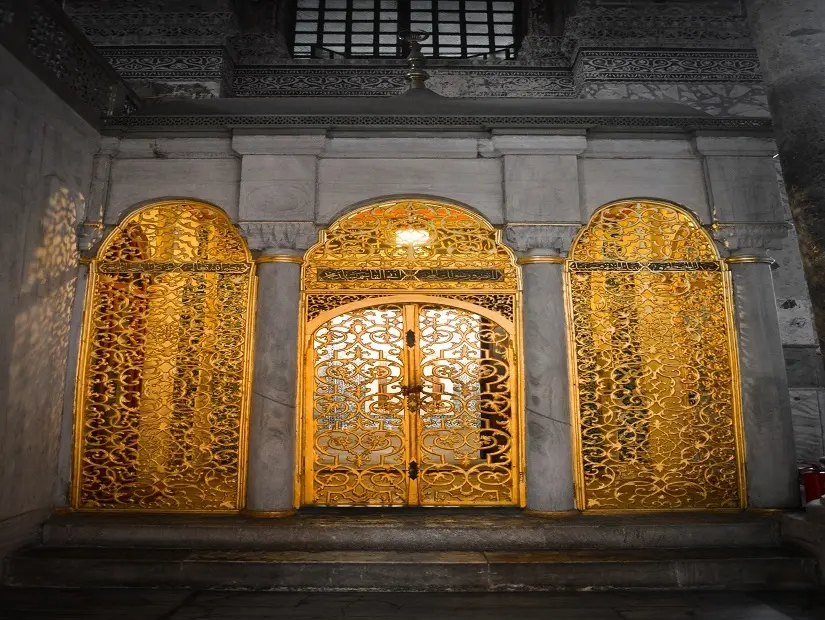
Presentation Mosaic
When you enter Hagia Sophia through the “Beautiful Gate”, you will see the “Offering Mosaic” at the end of the corridor. This mosaic, which was discovered during the restoration in 1849, depicts the Virgin Mary with the baby Jesus in her arms. Next to her are Emperor Justinian with a model of the city and the founder of the city, Constantine I.
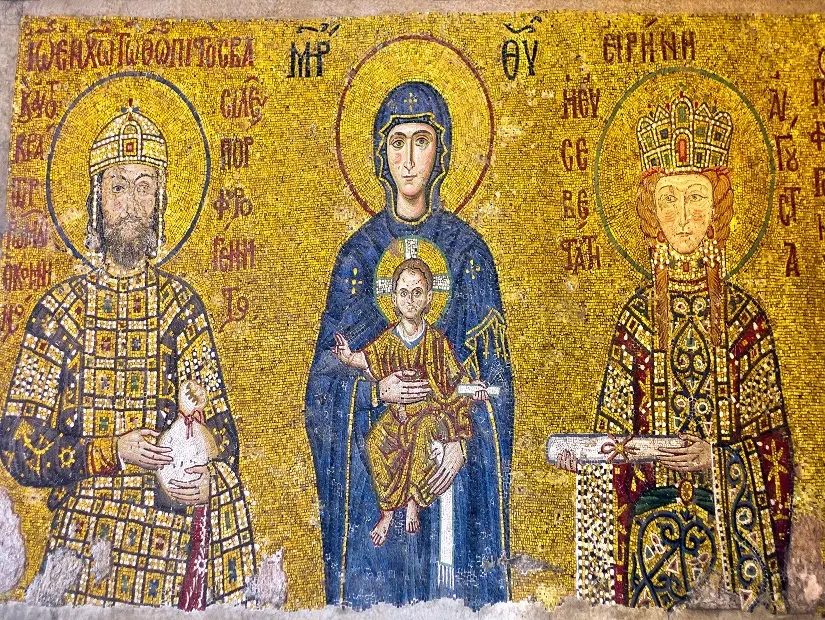
Deisis Mosaic
Also known as the “Prayer Mosaic”, it depicts the Virgin Mary and John the Baptist pleading with Jesus for all of humanity. When viewed from a distance, there is a detail that makes one feel as if they are looking at each other through Jesus’ eyes.
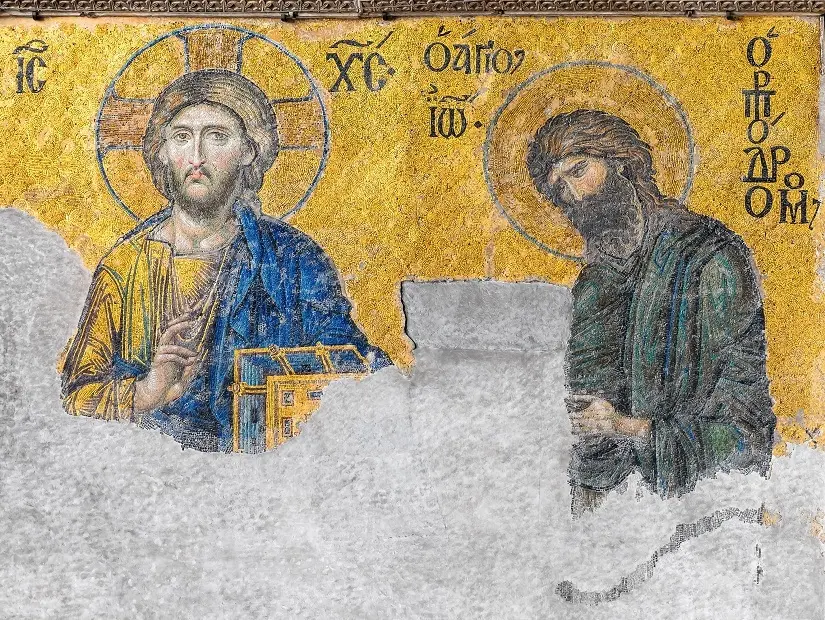
The Komnenos Mosaic
This mosaic contains depictions of Emperor Ionnes II Komnenos, his wife Irene, and their son Alexios II. The center of the mosaic features the Virgin Mary and the child Jesus. This mosaic was created in honor of the Komnenos family, who donated to Hagia Sophia.
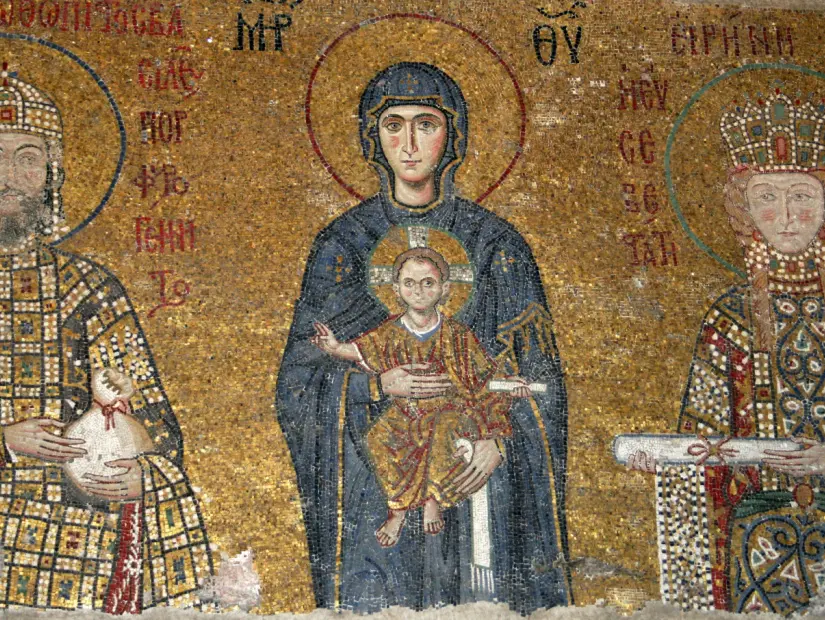
Apse Mosaic
This 5-meter-long mosaic shows the Virgin Mary on a throne decorated with precious stones, with the child Jesus on her lap. In the building used as a mosque, the mosaic is hidden by electronic curtains during prayer times.
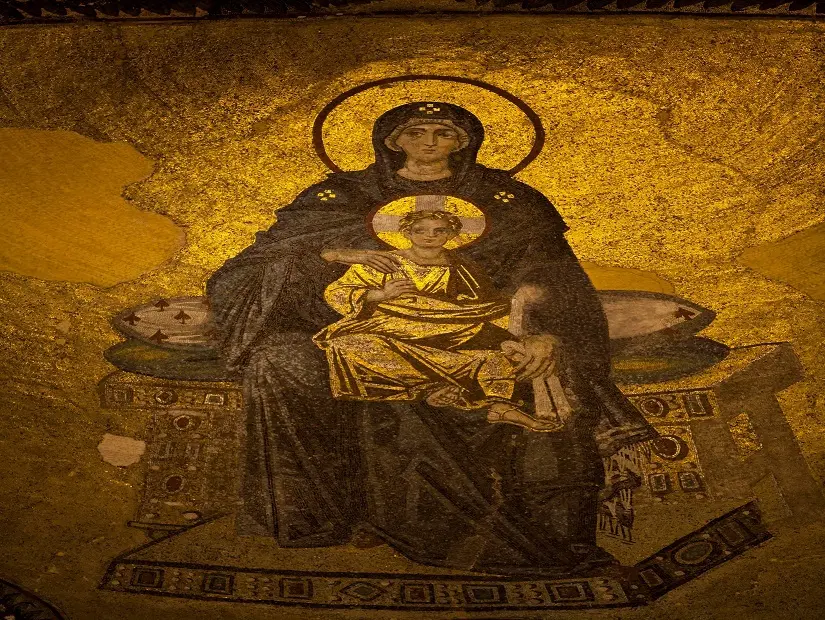
Seraphim Angels on the Pendentives
The six-winged Seraphim Angels are located on the pendentives and are believed to protect the throne of God. During the Ottoman period, the faces of the angels were covered with metal caps and covered with curtains during prayer times.
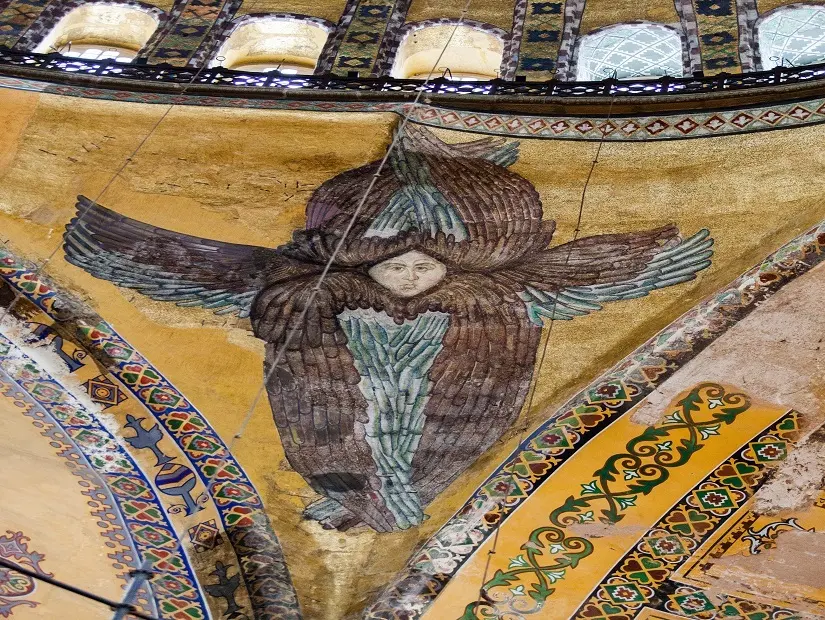
Ompallion
This point, where the coronation ceremonies of the Byzantine Emperors were held, is called the "Center of the World". The large circle in the center represents Jesus Christ, and the 12 smaller circles around him represent the apostles.
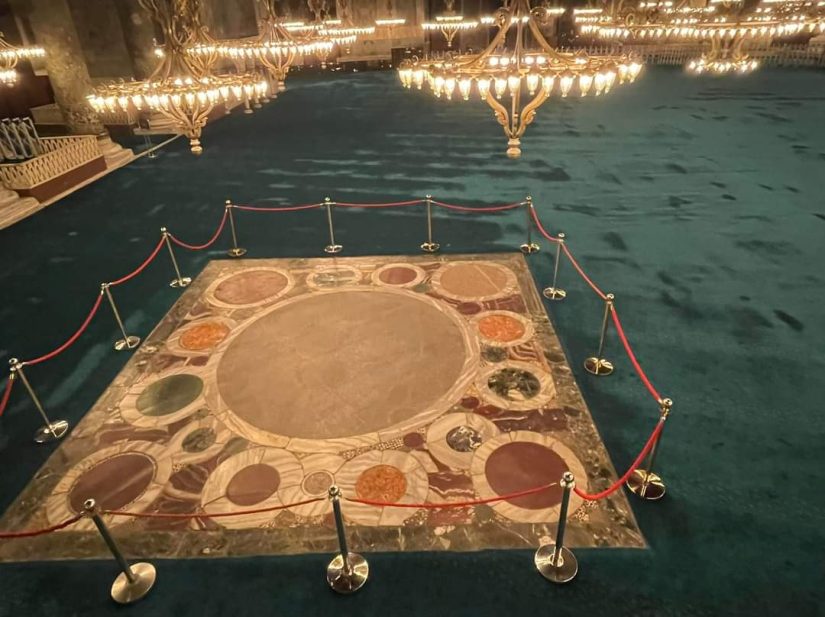
The Station of Khidr
According to legend, Hagia Sophia was considered a sacred place for those who wanted to meet Hızır. The "x" sign under the dome in the center is known as the Hızır Makam.
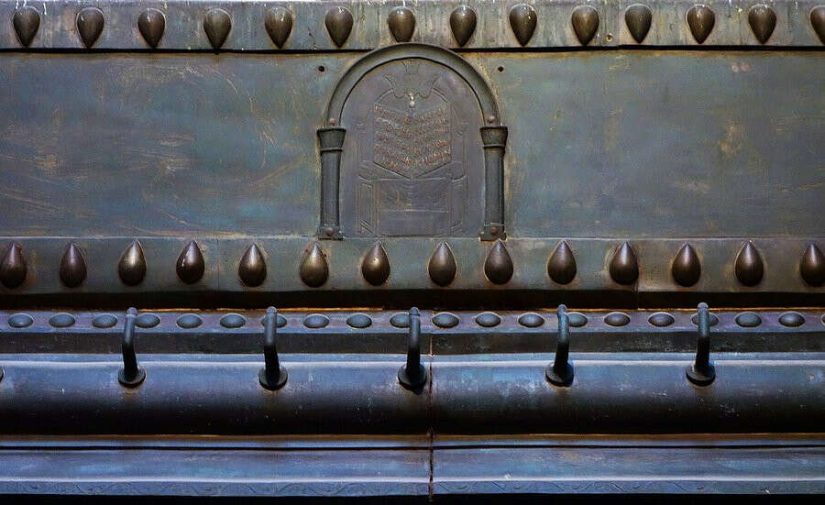
Weeping Column
This column, also known as the “Wishing Column”, is believed to cure diseases. Touching the hole in the middle of the column with your finger and then rubbing it on the diseased area has been seen as a way to find healing.
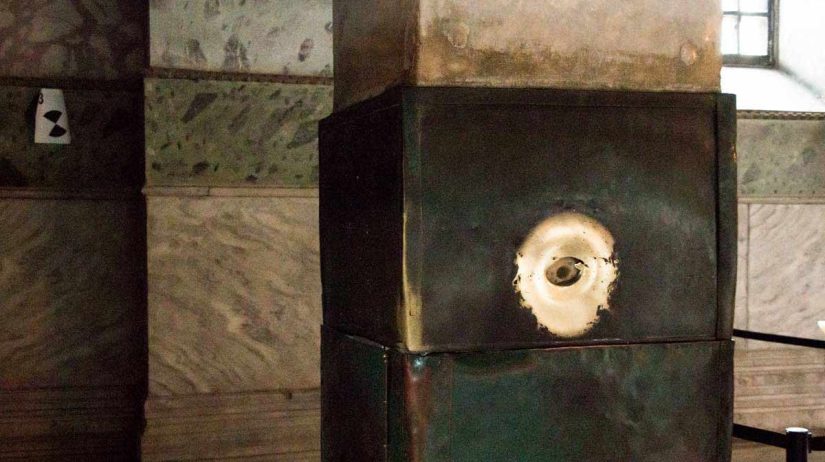
Baptismal Pool and Baptistery
The baptistery in the garden was once used to store oil. The baptismal pool, which was removed from the structure that was converted into a mausoleum during the Ottoman period, was restored and put back in place in 1943.
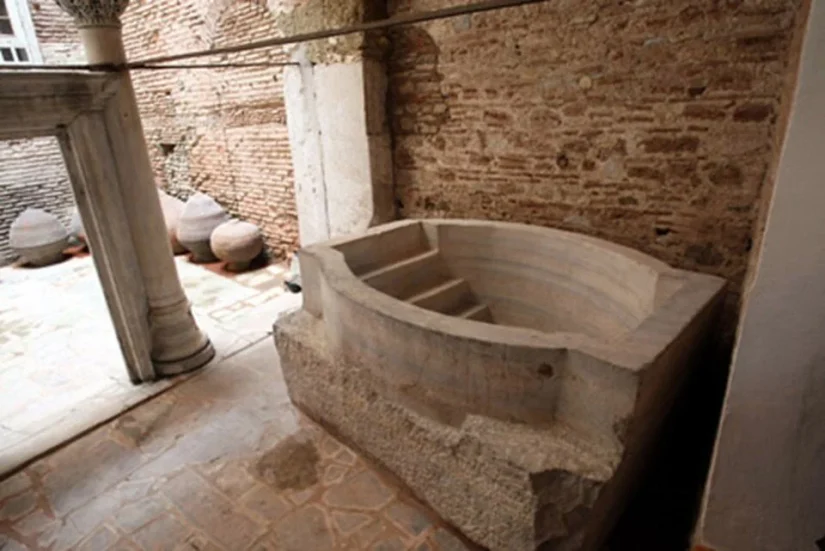
Marble Door
This gate, which is closed to public use, is a passage reserved only for the patriarchs. One side symbolizes heaven, the other side symbolizes hell.
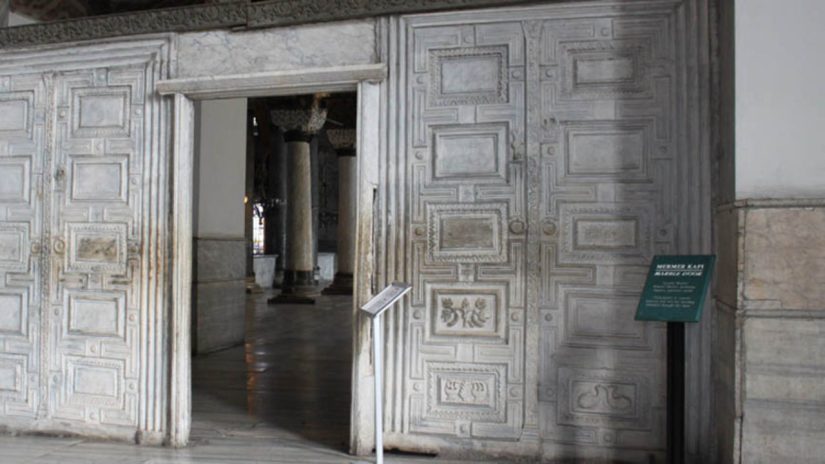
Viking Writing
On the upper floor, you can see an inscription written in the Runes alphabet belonging to a Viking soldier named "Halvdan". This inscription is an important clue about the history of the Vikings who came to Byzantium.
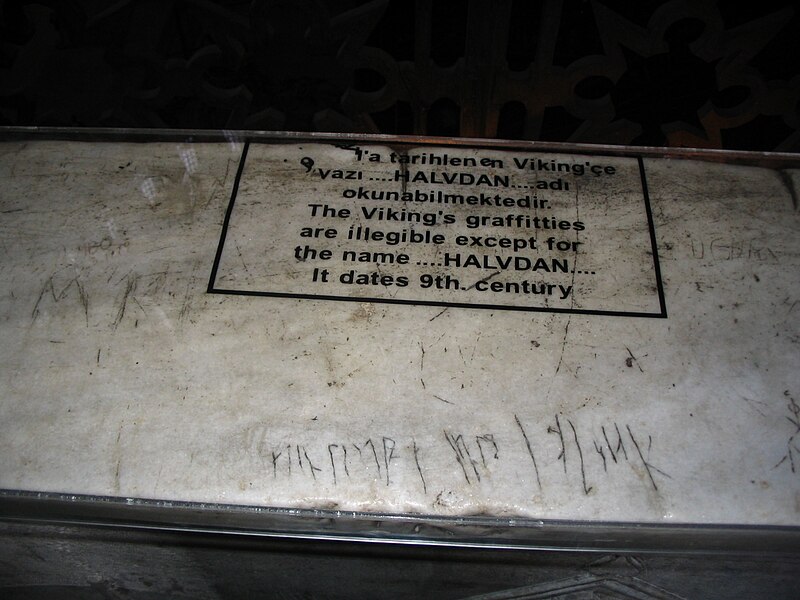
The Grave of Enrico Dandolo
Leader of the Fourth Crusade Enrico DandoloHe died in Istanbul in 1205 and was buried in Hagia Sophia. However, in 1261, the Byzantines opened his grave and threw his bones into the sea. Today, the grave has symbolic value.
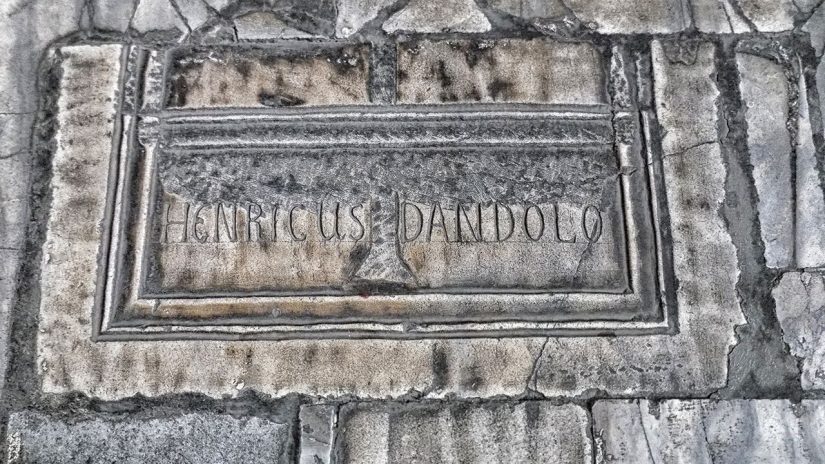
Hagia Sophia is a world heritage that impresses its visitors not only with its architectural structure but also with the history, legends and details it contains.
Where is Hagia Sophia Mosque?
Hagia Sophia Mosque, Istanbul Europe It is located in the heart of the Historical Peninsula on the 2nd Side. Located in Sultanahmet Square within the borders of Fatih district, this iconic structure is located in one of the most important historical points of the city. Karaköy, Sirkeci and Eminonu The Hagia Sophia Mosque is very close to central locations such as the ones on the European side and the ones coming from the Anatolian side, and is easily accessible.
How to Get to Hagia Sophia Mosque?
Reaching the Hagia Sophia Mosque is quite easy from both sides of Istanbul. You can easily reach it by public transportation such as Marmaray, tram and sea.
- Tram: You can use the Bağcılar-Kabataş tram line and get off at the Sultanahmet stop, which is a few minutes' walk from the Hagia Sophia Mosque.
- Marmaray: You can get off at the Sirkeci stop using the Marmaray line. From there, you can reach Hagia Sophia by a short walk or by taking the tram right next to the stop.
- Ferry and Engine: You can choose to go to the European side from the Anatolian side by sea. You can use the ferries that depart from Kadıköy or Üsküdar to Eminönü. When you arrive in Eminönü, you can easily reach Hagia Sophia by taking the tram or walking.
Hagia Sophia Mosque: Fees and Visiting Hours
Since the Hagia Sophia Mosque has the status of a mosque, entrance is free. However, in line with UNESCO's recommendations, a new visitor management plan has been put into effect as of January 15, 2024. Hagia Sophia has been on the UNESCO World Heritage List since 1985 and has been serving as a mosque since July 24, 2020.
Entry Fees
- Mosque section: Free
- Upper floor (special entrance fee):
- Foreign visitors: 25 Euros
- Citizens of the Republic of Türkiye: 850 TL
Visiting hours
- Mosque section: It is open to visitors 7 hours a day, 24 days a week. However, during worship times, especially Friday and daily prayers, visits may be limited.
- Upstairs: It can be visited every day until 19.00:XNUMX.
Note: Please note that entrance lines can be quite long during weekends and busy tourist periods. We recommend that you take this and the prayer times into consideration when planning your visit.
Secrets and Interesting Facts of Hagia Sophia
Hagia Sophia is a structure that draws attention with both its architecture and the stories it carries throughout history. Here are the unknown secrets and interesting details of Hagia Sophia:
The Name and Meaning of Hagia Sophia
- “Hagia” means “holy” in Ancient Greek, and “Sophia” means wisdom. Together they mean “Holy Wisdom” and in the Orthodox sect refer to one of the three attributes of God.
Architectural Details
- Hagia Sophia was built within a rectangular structure measuring 96 meters by 66 meters.
- Its dome is 31 meters in diameter and 56 meters above the ground, making it equivalent to the height of a skyscraper.
- The bricks used in its construction were brought from Rhodes and their feature is that they do not sink in water.
Historical and Architectural Records
- Hagia Sophia is the oldest cathedral in the world and is also known as the fastest built cathedral.
- It was the largest cathedral in the world until the construction of the Seville Cathedral. Today, it is the fourth largest cathedral.
The Ottoman Period and Mimar Sinan
- The chief Ottoman architect, Mimar Sinan, repaired the dome of Hagia Sophia in 1573 and added retaining walls to strengthen the structure.
- Its single red minaret was erected in memory of the conquest of Istanbul and was built to symbolize those who sacrificed their lives for the conquest.
Materials and Techniques
- A special volcanic tuff mixture of unsalted river sand, lime and brick dust was used in the construction of Hagia Sophia. This material has a structure similar to cement and has helped the building to survive for centuries by allowing it to repair itself.
Underground and Tunnels
- It is rumored that there are tunnels and underground tombs under Hagia Sophia. It is thought that these tunnels were used as shelters and secret passages during the Byzantine period.
Earthquake and Repair
- After a major earthquake in the 16th century, Hagia Sophia was rebuilt with taxes collected from the public.
Legends and Stories
- Hagia Sophia is considered an engineering marvel with its “self-repairing” structure.
- The red minaret symbolizes the memory of the conquest and the martyrs.
- The size of its dome and its height above the ground give the building the air of a place of worship extending into the sky.
The fascinating architecture of Hagia Sophia and the secrets told throughout history make it not just a structure, but also a mirror of the past and a common heritage of humanity.
A New Era Begins in Hagia Sophia
The visitor experience at Hagia Sophia, one of Istanbul’s most popular historical sites, has been improved with new regulations implemented by the Ministry of Culture and Tourism in 2024. Those who come to the mosque for worship and those who visit for touristic purposes are now directed through separate entrances. Thanks to this practice, worshippers are not disturbed and long queues are prevented.
With the new system, visitors can tour Hagia Sophia in a quieter and more orderly environment. Thanks to the QR code-based headphone guidance system, tourists can use their own headphones or get disposable headphones to receive information in 23 different languages. In this way, the religious atmosphere of the mosque is respected, while cultural richness is effectively conveyed to visitors.
With a magnificent view from Sultanahmet Park, Hagia Sophia continues to preserve its value as both a place of worship and a cultural heritage with these arrangements.
Hagia Sophia Awaits Visitors
The Ministry of Culture and Tourism has completed the restoration and conservation work it started at the Hagia Sophia Mosque and created a special gallery area for visitors. This new arrangement offers visitors the opportunity to see the unique traces of both the Byzantine and Ottoman periods more closely.
Visitors will be able to explore the mosque's prayer hall floor and additions from the Ottoman period, and pass through the "Gate of Heaven and Hell" to examine mosaics from the Byzantine period. Artistic and architectural riches from different periods of Hagia Sophia are meticulously exhibited in this gallery.
As of 2024, the entrance fee for visitors wishing to visit the upper floor will be 25 Euros. This area offers history and art enthusiasts in particular the opportunity to experience the multi-layered heritage of Hagia Sophia in more depth.
Hagia Sophia awaits its visitors as always with its fascinating view and rich history. The magnificence of this historical structure reveals the cultural identity of Istanbul.











